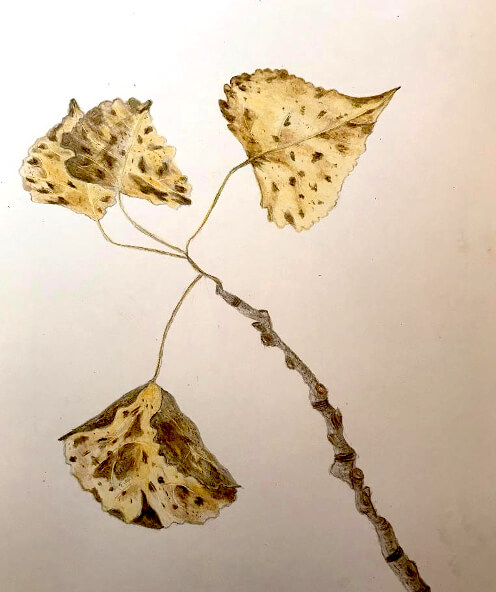The Importance of a Cottonwood Twig
By Deb Mowry
Broadcast 2.23 & 2.26.2022

Cottonwood leaves on a bumpy stem. Drawing © Deb Mowry.
Listen:
My boots crunch the snow on my timbered yard as I hike among the trees. I usually stop and say hello to each of them. But today, I am focused on a solitary tall cottonwood tree in the distance. I shuffle my way through the snow and greet my old friend with a soft gloved touch to its deep gray furrowed bark. I look up, and up and further to the distant fanning branches. My tree can grow to 170 feet tall and the crown can have a width of 60 to 100 feet.
Up high, I see branches with leaf buds patiently waiting for spring. A recent winter storm has torn many small twigs with these precious buds from the tree and they now litter the snowy ground. I like picking up a knobby, gnarly twig and searching for large bud scale scars, reminders of where the leaves grew seasons before. They look like two or three raised rings circling the twig like a bumpy knuckle. I eagerly find the scar and then break it with a quick, forceful snap.
There, I see what I am looking for: a reddish-colored star located in the center of the stem. I count five points. The star is actually the pith of the plant, which transports vital nutrients to twigs and leaf buds. This star shape is common to trees of the willow family, which include cottonwoods, aspens, willows and poplars. But of all these trees it is the cottonwood that many Native Americans elevate to sacred symbolism.
The Lakota call it the tree of life, due to the star, and use its branches in their Sun Dance ceremony. Dakota Native Americans tell a story of a little star who wanted to hear the sounds and songs of humans and hid in the cottonwood so as not to disturb the people as they worked. Cheyenne and Arapahoe also noticed the star. In their tradition, if the Spirit-Of-The-Night-Sky needs more stars it calls upon the Wind Spirit, who blows and causes cottonwood twigs to break, releasing their stars to heaven.
The cottonwood twig is also important to Native Americans in other ways. I think of this as I pick up more broken twigs and touch the terminal buds. If it were spring, I would feel a stickiness when touching them. Cottonwood buds contain a yellow resin, a concoction of over ten different chemicals, one being salicin. It behaves similar to acetylsalicylic acid, better known as aspirin, due to its anti-inflammatory properties. Native Americans learned to use the buds as medicine and this practice continues today as people make lotions and ointments with it.
Of course, not all twigs fall to the ground. Most stay on the tree and leaf buds open to become triangular-shaped leaves. This shape gives the eastern cottonwood its scientific name: Populus deltoides. The word reminds me of the deltoid muscle in my shoulder-it is triangle shaped too. In summer I enjoy hearing the wonderfully shaped leaves make a rustling sound as the wind grazes their surface. A flat petiole, or stem, allows the leaves to clatter next to each other, making the unique musical sound. Black Elk, an Oglala Sioux Holy Man, said it well: “Perhaps you have noticed that even in the slightest breeze you can hear the voice of the cottonwood tree; this we understand is its prayer to the Great Spirit, for not only men, but all things and all beings pray to Him continually in different ways.”
Looking down at the unopened buds on the twigs in my hand, I reflect on Black Elk’s words. These buds may be lost, but high up in the tree are so many more just waiting to flutter in a summer breeze.
Every week since 1991, Field Notes has inquired about Montana’s natural history. Field Notes are written by naturalists, students, and listeners about the puzzle-tree bark, eagle talons, woolly aphids, and giant puffballs of Western, Central and Southwestern Montana and aired weekly on Montana Public Radio.
Click here to read and listen to more Field Notes. Field Notes is available as a podcast! Subscribe on iTunes, Google Play, or wherever you listen to podcasts.
Interested in writing a Field Note? Contact Allison De Jong, Field Notes editor, at adejong [at] montananaturalist [dot] org or 406.327.0405.
Want to learn more about our programs as well as fun natural history facts and seasonal phenology? Sign up for our e-newsletter! You can also become a member and get discounts on our programs as well as free reciprocal admission to 300+ science centers in North America!












